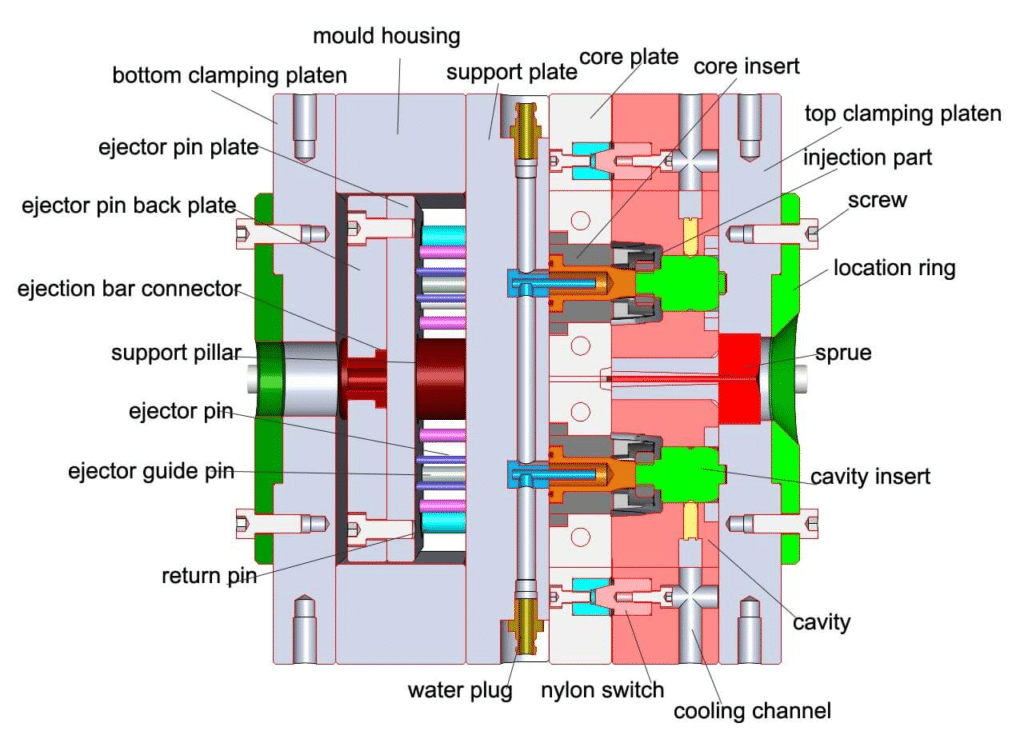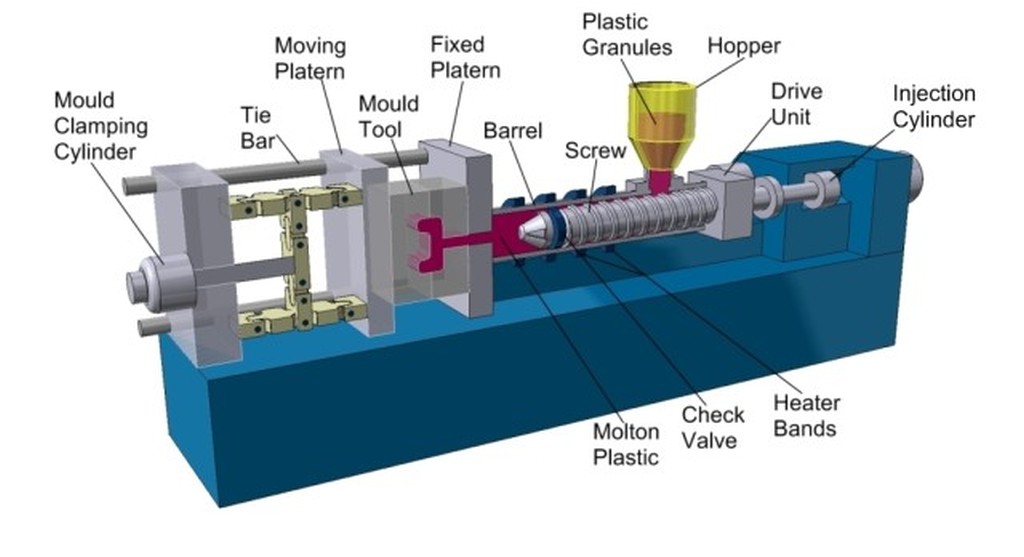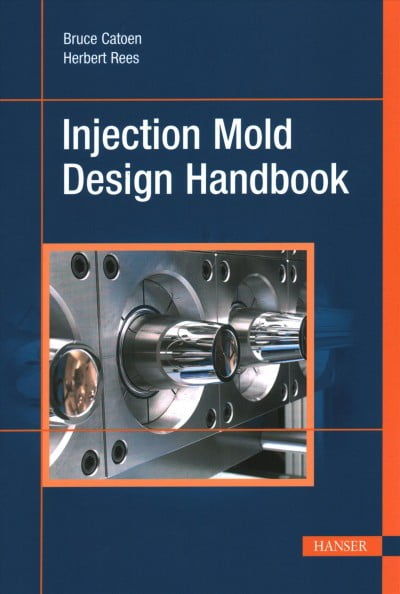Introduction to Injection Mold Design
Injection mold design is super important in manufacturing. It’s all about creating the molds that help make different plastic parts using the injection molding method. How you design these molds can really affect the quality of the final product and the costs involved. Take a water bottle, for example; you’ve gotta think about the shape, size, and materials. Every little detail matters when it comes to the time it takes to produce and how much waste you end up with.
Why Injection Mold Design Matters in Manufacturing
You can’t stress enough how important injection mold design is. It’s basically the backbone for all sorts of industrial stuff. Here’s why it’s a big deal:
- Cost Efficiency: When molds are designed well, they waste less material and require less rework, which saves both time and money.
- Quality Assurance: Good design means you get high-quality products that perform consistently well.
- Time-to-Market: A smart mold design speeds up how fast you can get your products out there, so you can meet demand quickly.
In short, nailing down injection mold design can really boost productivity and profits in manufacturing.
Basics of Injection Molding
You’ve gotta get a grip on the basics of injection molding if you’re in manufacturing. At its core, it’s about pushing molten material into a specially crafted mold to create specific shapes. A well-made mold can churn out thousands of the same part, making it a really efficient way to produce things. Think of a smartphone casing. The design needs to work around features like buttons and connectors to make sure everything fits just right.
Materials Used in Injection Molding
The materials you pick for your injection molds really affect how they perform. Here are some commonly used ones:
- Steel: Very tough and perfect for high-volume production.
- Aluminum: It’s lighter and cheaper, great for smaller runs and quick prototypes.
- Copper Alloys: These are awesome for heat transfer and are often used in cooling systems.
Choosing the right material is key to balancing costs with what you need for production.
Types of Injection Molds
There’s a bunch of different injection molds, each made for specific jobs:
- Single Cavity Mold: Makes one part at a time, offers great precision.
- Multi-Cavity Mold: Can produce several identical parts all at once, which is super efficient.
- Family Mold: Built to create different parts at the same time, perfect for assembling multiple components together.
Knowing these mold types helps manufacturers pick the best fit for their production needs, which boosts efficiency and improves product quality.

Design Principles for Injection Molds
Wall Thickness Considerations
When you’re designing injection molds one key thing to think about is wall thickness. Keeping the wall thickness uniform helps with even cooling and cuts down on distortion when the molding happens. A good rule of thumb is to aim for a thickness between 1.5 mm and 4.0 mm depending on the type of material you’re using. From what I’ve seen inconsistent wall thickness can cause problems like sink marks which really mess with how the product looks.
Parting Line Design
Next up is the parting line design. This is where the two halves of the mold come together and where you place it makes a difference in how the part looks and works. You want the parting line in a spot that won’t mess with how the part functions or its appearance. It’s pretty cool to see how a well-placed parting line can really change the final product’s look just like seams can shape clothing.
Draft Angles and Texturing
Lastly draft angles and texturing are really important in mold design. Draft angles help with getting parts out of the molds easily without any damage. Usually a draft angle of about 1 to 3 degrees works well. Texturing can add some nice looks and improve grip too. For example a textured finish on tools can stop them from slipping. Together these aspects smooth out production and make the end product better for users.

Injection Mold Components
Core and Cavity
The core and cavity are at the heart of any injection mold. The core forms the inside shape of the part while the cavity shapes the outside. Together they decide what the molded product finally looks like. From my experience making sure these components are precise is super important. Even a tiny mistake can lead to big issues like misalignment or a bad fit which can ruin the whole production run.
Runner and Gate Systems
Up next are the runner and gate systems. The runner is the channel that moves molten plastic from the injection machine to the mold and the gate is where the plastic enters the cavity. Having an efficient design for these systems helps cut down on waste and makes sure the flow is consistent. A well-placed gate can speed up filling and reduce pressure drop which helps with quicker cycle times.
Cooling and Ejection Systems
Finally cooling and ejection systems are key for how well injection molds work overall. Cooling channels are often part of the mold design and they help keep the temperature right to solidify the plastic quickly and evenly. Ejection systems help push the molded part out once it’s cooled. Picking the right ejector pins or plates can really lower the risk of damaging the part especially if it has delicate features. Together these components make sure production flows smoothly and keeps the product quality high.

Tooling and Prototyping in Injection Molding
Quick Prototyping Methods
When it comes to making stuff in injection molding, quick prototyping techniques have totally changed the game. Things like 3D printing and CNC machining let makers whip up working models really fast, which speeds up the whole design process. I remember a project where a client needed a prototype for a new toy. With a 3D-printed version, we spotted some design issues right away and could tweak things before we even thought about tooling. This saved us a ton of time and resources.
Tooling Design Tips
Now let’s talk about tooling design. There are a few important things to think about. These include what materials to use, how complex the mold needs to be, and keeping costs down. If you get the tooling right, it can cut down on production delays and enhance the quality of the final product. Here are some key points to keep in mind:
- Material Durability: Picking tough materials like steel or aluminum for molds really affects how long the tooling will last.
- Ease of Maintenance: Make sure designs allow easy access to parts so repairs can be done without a hassle.
By keeping these factors in check early on, manufacturers can have smoother production experiences and improve the quality of their products.

Common Design Challenges and Solutions
Sink Marks and Warping
When it comes to making parts through injection molding, issues like sink marks and warping can really get in the way of creating top-notch products. Sink marks happen when thicker areas cool off slower than thinner parts, which can lead to those little dips on the surface of the molded item. I ran into this problem once while working on a tricky electronic housing. To tackle it, we tweaked the wall thickness and added some extra cooling channels in the mold. This helped us cut down on sink marks and made the part look a lot better.
Venting and Shrinkage Issues
Besides sink marks, venting and shrinkage can also throw a wrench in the injection molding process. If there’s not enough venting, air can get trapped and cause issues like burns or parts not filling completely. Shrinkage can also mess with how stable the part is as it cools down. Here are a couple of tips to help with these problems:
- Improve Venting: By adding vent lines or putting vents in smart places, you can help air escape more easily.
- Consider Shrinkage: Design your parts with shrinkage in mind and use materials that shrink in a predictable way to keep everything accurate.
By tackling these issues from the get-go, you’ll be in a much better spot to make quality parts. manufacturers can significantly improve production efficiency and product quality.

Cool Tips for Injection Mold Design
Overmolding and Insert Molding
Using overmolding and insert molding can really spice up injection mold design. Overmolding is when you add a second layer over an already molded part to improve things like grip or cushioning. I once helped design a toothbrush where a soft rubber grip made it way more comfortable to use. It’s not just about looking good either; it cuts down on production steps and costs.
Multi-Cavity and Family Molds
Multi-cavity and family molds are great for boosting production efficiency. With a multi-cavity mold, you can make several identical parts all at once, which speeds things up a ton. Family molds, on the other hand, let you create different parts in one go, perfect for stuff that has various components. When I worked on a product line with different container sizes, family molds were a lifesaver. By using these advanced techniques, makers can cut down production times and create top-notch products that fit what people want.
Simulation and Analysis in Injection Molding
Mold Flow Analysis
When it comes to injection molding, using simulation and analysis is super helpful for great design and production. Mold flow analysis is awesome for figuring out how molten plastic will move through the mold, helping designers spot potential problems before they even start making stuff. One time, we used this analysis to find spots that were likely to not fill completely. By changing the runner design, we cut cycle times and boosted the quality of the parts, making production smoother.
Stress and Thermal Analysis
Stress and thermal analysis is another biggie. It looks at how materials react to pressure and heat changes. If there are high-stress areas, you might end up with warping or breakdown, and that’s not something anyone wants. For a project making a high-performance car part, we used thermal analysis to predict cooling rates and stress points. This smart move let us tweak the design to make sure the part would hold up under tough conditions. By using these simulations, makers can boost reliability and efficiency while avoiding costly mistakes.

Design for Manufacturability Tips
Designing for Cost Efficiency
When you’re working with injection molding, making things cost-effective is super important. Smart design can save a lot on production costs without skimping on quality. This usually means picking the right materials, keeping shapes simple, and shortening cycle times. During one of my recent projects, we realized we could simplify a complicated part without losing its function. Cutting back on unnecessary features not only brought down material costs but also sped up production.
Design Optimization Tips
To take manufacturability to the next level, you gotta think about design optimization strategies. Here are some you might want to employ:
- Standardizing Components: Whenever you can, use off-the-shelf parts to save time and money.
- Design Iteration: Keep reviewing and tweaking your designs to make sure they keep getting better.
- Collaborating with Manufacturers: Chat with your production team during the design phase to get practical tips that can lead to smarter choices.
If manufacturers stick to these tips, they can make products that not only meet what customers are looking for but also keep the budget in check, setting themselves up for long-term success.